Part two of three of the series Recommended Readings on Education.
Part One: K-12 Education: Policy Analysis and Reform
Part Three: American Higher Education’s Maladies and Remedies
Curriculum and teaching strategies are indispensable to the success of students, but less discerning voices in education policy have left schools across the nation with unproven and outright dogmatic philosophies. At times policy makers seem all too eager to trade learning opportunities for political talking points (such as claiming that learning basic arithmetic marginalizes minorities).
The failure to remedy these deficiencies in school subject matter and teaching methods neglects students’ chances to gain invaluable knowledge. Seeking a cure, this annotated bibliography offers a comprehensive introspection into key findings in the education literature which will serve discussions regarding what children are taught, how they are taught, and how we can do better.
This bibliography is a part of the K-12 Series together with the Policy Analysis and Reform bibliography. As well, this bibliography is a project of the Independent Institute’s Center on Educational Excellence and, will undergo periodic updating and refinement. Please send us your suggestions for future iterations, and share the list with others to encourage their feedback.
Fads and fallacies criticized include: action civics, child centered learning, communicative approach to foreign language teaching, critical thinking without background knowledge, developmentalism, ethnomathematics, learning styles, math-light physics, radical constructivist teaching methods, “Real world” math, self-esteem boosting, social studies and American history based on critical race theory, transitional bilingual education, unguided discovery learning, unstructured cooperative learning, “whole” language reading instruction, the “writing process” method.
If you can read just one item on this list, then make it The Schools We Need, by E.D. Hirsch Jr. If you can read only two, make your second choice Why Don’t Students Like School?, by Daniel T. Willingham.
“A Brief History of American K-12 Mathematics Education in the 20th Century,” by David Klein. In Mathematical Cognition, ed. James Royer. Information Age Publishing, 2003.
David Klein, a university mathematics professor and New Left historian of math education, writes, “The political struggles and policy changes in mathematics education in the 1980s, and especially the 1990s are the major topics of this chapter. However, the events of the final two decades of the 20th century are more easily understood in an historical context. Throughout the 20th century the ‘professional students of education’ have militated for child-centered discovery learning, and against systematic practice and teacher-directed instruction. In some cases, progressivist math programs of the 1990s were intentionally without student textbooks, since books might interfere with student discovery. ... [T]he dictum from educators of the 1990s and late 1980s [was] that the teacher should be ‘a guide on the side and not a sage on the stage.’ ...”
 The Abolition of Man, by C. S. Lewis. HarperCollins, 2015. Download PDF
The Abolition of Man, by C. S. Lewis. HarperCollins, 2015. Download PDF
C.S Lewis defends what he calls “the doctrine of objective value,” defined as “the belief that certain attitudes are really true, and others really false, to the kind of thing the universe is and the kind of things we are.” Lewis criticizes progressive educators who reject the principles of natural law which (as he details) are found in every major religious tradition.
“Academic Achievement and the Structure of Competition,” by James S. Coleman. Harvard Education Review, vol. 29, no. 4 (Fall 1959).
Education Next writes, “While what [Coleman] characterizes as ‘interpersonal competition in scholastic matters’ generates social pressure not to excel, ‘interscholastic competition in athletics has quite the opposite effect.’ In fact, he cites athletics, where ‘there is no epithet comparable to “curve-raiser,” there is no ostracism for too intense effort or for outstanding achievement,’ as a model for the kind of competition he believes needs to be introduced to a school’s scholastic endeavors.”
In the motion picture “Stand and Deliver,” you can see math teacher Jaime Escalante harness his students’ competitive spirit as he prepares them to pass the Advanced Placement calculus examination. Their opponents, he tells them, are those who don’t believe they can do it. Math Olympiads and debate competitions endeavor to enlist the same competitive spirit. Coleman calls for “interscholastic (and intramural) competition” in academic achievement.
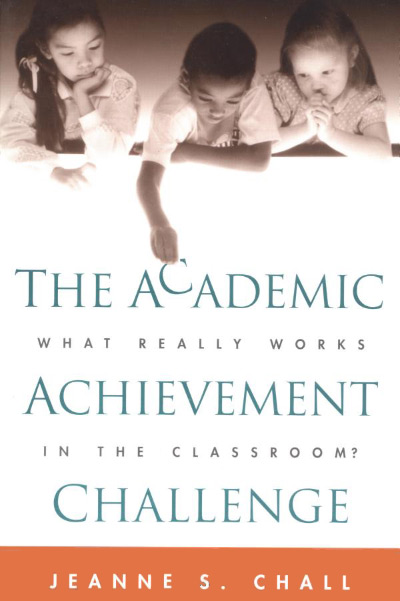 The Academic Achievement Challenge: What Really Works in the Classroom?, by Jeanne S. Chall. Rev. ed., Guilford Press, 2002.
The Academic Achievement Challenge: What Really Works in the Classroom?, by Jeanne S. Chall. Rev. ed., Guilford Press, 2002.
Guilford Press: “From the late Jeanne S. Chall, former Professor of Education at Harvard University and a leading figure in American education—the book reviews and evaluates the many educational reforms and innovations that have been proposed and employed over the past century. Systematically analyzing a vast body of qualitative and quantitative research, Dr. Chall compares achievement rates that result from traditional, teacher-centered approaches with those resulting from progressive, student-centered methods. Her findings are striking and clear: that teacher-centered approaches result in higher achievement overall, with particular benefits for children of lower socioeconomic status and those with learning difficulties. Offering cogent recommendations for practice, the book makes a strong case for basing future education reforms and innovations on a solid empirical foundation. Diane Ravitch writes, ‘It would create a revolution in American education if every teacher, parent, and school board member were to read this book. What a wonderful, informative, readable, commonsense discussion of what works in classrooms and what usually doesn’t work.’”
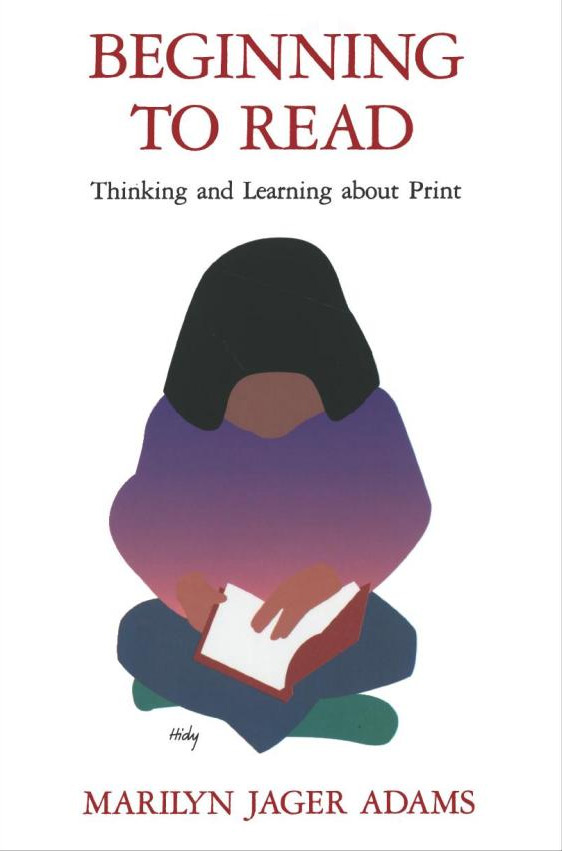 Beginning to Read: Thinking and Learning about Print, by Marilyn Jager Adams. Bradford Books, 1994.
Beginning to Read: Thinking and Learning about Print, by Marilyn Jager Adams. Bradford Books, 1994.
Bradford Books: “Beginning to Read reconciles the debate that has divided theorists for decades over the ‘right’ way to help children learn to read. Drawing on a rich array of research on the nature and development of reading proficiency, Adams shows educators that they need not remain trapped in the phonics versus teaching-for-meaning dilemma. She proposes that phonics can work together with the whole language approach to teaching reading and provides an integrated treatment of the knowledge and process involved in skillful reading, the issues surrounding their acquisition, and the implications for reading instruction.”
“Blame Woodrow Wilson for Americans’ Lack of Historical Literacy," by Williamson M. Evers. National Review Online, December 1, 2015.
Evers writes, “We need to hold [Woodrow Wilson] responsible for the fact that many Americans don’t know the timeline of world or American history and don’t know much about how constitutional government works in the United States: [I]n 1916, the Wilson administration put the clout of the federal government behind a new curricular development—social studies. ...
“‘Social studies’ is a cross-disciplinary K–12 curriculum of history, civics, geography, and related subjects—but, crucially, the curriculum is focused not on chronology or governmental structure and processes; [instead] social-studies teachers [are supposed to] focus on ‘concrete problems’ that are ‘of vital importance to society.’”
“Board Adopts Active Physics for 9th Graders: Community Says It’s ‘Comic Book’ Education,” by Yvette tenBerge. La Prensa (San Diego), June 15, 2001.
On the non-mathematical 9th-grade physics courses (part of a “physics first” science sequence) that began in San Diego public schools in 2002 and were in place for the following five years. From the article: “Martin Teachworth [high school physics teacher] offers his theory as to why an 8th-grade level program like Active Physics was selected in the first place, and why the normal textbook selection process was skipped. ‘The reason this program has been adopted is because it is a very, very low-level program. You can put any student in there, and since they will be working in groups, they will not be individually responsible. You can then say, “Every kid in my district is taking physics” and that they received passing grades,’ says Mr. Teachworth. ‘The only problem with this is that these students have not actually learned physics.’
“Indeed the four, thin Active Physics ‘booklets’ that students will be using ... are very different [from] the comprehensive, Conceptual Physics textbooks normally used. Words like ‘humorous,’ ‘entertain,’ and ‘magic’ jump out at the reader, and comic book-like pictures decorate the pages. Although this might catch the attention of students who would not normally be interested in science, critics of Active Physics are concerned with the program’s lack of mathematics and factual material, and the scarcity of quality sample problems and thorough explanations. ...
“Paul Clopton, a biomedical statistician whose daughter attends La Jolla High School, ... sums up the opinion of the majority of teachers and parents who have done their homework on Active Physics. ‘The point of the program is for the least able kids to have exposure to science. It should be called “Pre-Physics” or “Middle School Physics Taught in High School.” Some people are saying that it should be taught in 8th grade, but I am not sure it is even that high of a content level,’ says Mr. Clopton, who equates the level of Active Physics to the level of books he bought for his children when they were nine- and ten years old. ‘The biggest consequence is that students will waste a year, and some people will believe that our kids will have actually learned physics. After taking this course, they can be considered to be done with taking physics, and they will not pass the state physics test.’”
 The Child as Poet: Myth or Reality?, by Myra Cohn Livingston. Horn Book, 1984.
The Child as Poet: Myth or Reality?, by Myra Cohn Livingston. Horn Book, 1984.
Alethea K. Helbig writes, “[Livingston has written numerous articles that] describe her methods of teaching children to write poetry. ... One of these, ‘But Is It Poetry?’ (Horn Book, December 1975 and February 1976) questions whether the poetry being written by children and lauded by adults could really be considered good, if judged by established critical standards. In ‘But Is It Poetry?,’ Livingston takes severely to task those who accept almost anything that children turn out no matter how shoddy or shallow in the critical sense, laud it as poetry, and publish it as artifact. ‘We do our children a striking disservice when we accept for publication this work in the name of poetry,’ she asserts, maintaining also: ‘I have become convinced over a period of years that early adulation does more harm than good . . . many years of teaching have convinced me that making this learning process [of writing poetry] an end in itself does ultimate harm to the child’s growth. At an age when children should be striving to improve by profiting from error, their work is accepted as complete, finished, perfect.’”
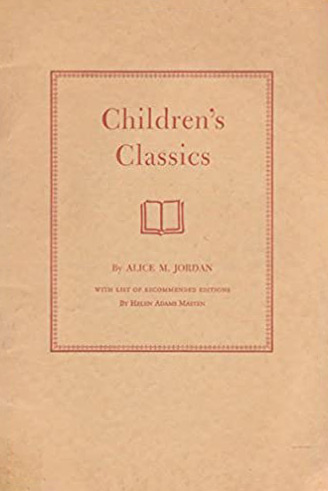 Children’s Classics, by Alice M. Jordan, with a List of Recommended Editions, by Helen Adams Masten. Horn Book, 1967. Download PDF
Children’s Classics, by Alice M. Jordan, with a List of Recommended Editions, by Helen Adams Masten. Horn Book, 1967. Download PDF
Sixty-six of “the best books ever written for, or adopted by, children.” This pamphlet sets forth a canon of children’s literature and is a must for parents, gift-giving grandparents, librarians, curriculum designers, and teachers. Jordan’s essay first appeared in The Horn Book Magazine in January-February 1947.
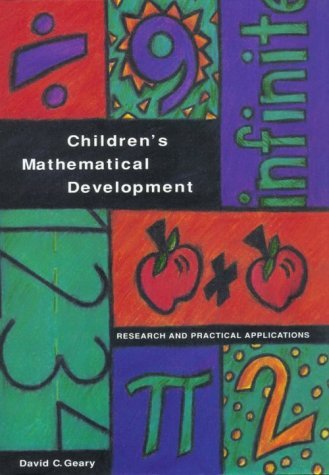 Children’s Mathematical Development: Research and Practical Applications, by David C. Geary. American Psychological Association, 1996.
Children’s Mathematical Development: Research and Practical Applications, by David C. Geary. American Psychological Association, 1996.
APA PsychNet writes, “Children’s Mathematical Development [offers] the first comprehensive treatment of number-skills development from infancy through adolescence. [The author] presents basic research in early number development, arithmetic, and mathematical problem solving; explores theoretical perspectives; and discusses implications for educators, offering his own thought-provoking conclusions.
“[He also] identifies three different forms of disability and describes specific math-related cognitive deficits. Using hard data, he critiques current philosophical approaches to education reform, offers suggestions for how to improve the teaching of math procedures and concepts, and examines how to address math anxiety and remediate math disability.”
Robert B. Davis writes, “Children’s Mathematical Development ... stands largely outside the world of mathematics education scholars. No one is likely to confuse David Geary with Tom Romberg, Susan Jo Russell, Carolyn Maher, Deborah Loewenberg Ball, or many other mathematics educators whose points of view play such a large role ... in recent ‘math ed’ developments.”
“Civic Education Reconsidered,” by James W. Ceaser and Patrick J. McGinn. The Public Interest, whole no. 133 (Fall 1998): 84 -103. Download PDF
Ceaser and McGinn write, “Rather than abandoning the civic idea as the New Left had done, Rorty maintains that the goal of the Left should be to recapture it. He calls for a creative melding of Walt Whitman and John Dewey which will enable the Left to tell a new ‘story’ of the nation’s past and to forge a new dream of its future. Others in this movement invoke different figures as spiritual ancestors—Herbert Croly and even Alexander Hamilton have found renewed favor. ...
“The revival today of the idea of civic education is a healthy development, above all because it promises to undermine the anti-civic orthodoxy that has prevailed in many of our schools over the past generation. But it contains the danger, already evident in much of the emerging debate, of shifting national thinking toward the notion that the civic must be single and public. This premise denies the history of American education, in which a sense of national unity has been promoted through the mutually reinforcing traditions of public and private schools. It also denies the genius of the American political system. Properly conceived, the civic ought to refer to a spirit of public concern and of public regard, not to one set of ideas defined by the government. In the final analysis, the real threat to American unity lies not in the existence of multiple civic ideals—even when they are engaged in an energetic and rancorous debate—but in the absence of civic engagement or in the standardization of the civic idea.”
“Comment,” by E.D. Hirsch Jr. (on The Ed School’s Romance with Progressivism by David F. Labaree), Brookings Papers on Educational Policy, no. 7 (2004): 112-117.
Hirsch writes, “The ideas with which [prospective teachers are forcibly indoctrinated in ed schools] are a mixture of falsehoods and half-truths that have had the historical effect of depressing student achievement and widening the gap between advantaged and disadvantaged children.”
Connected Knowledge: Science, Philosophy, and Education, by Alan Cromer. Oxford University Press, 1997.
Cromer writes, "Most educational reformers accept, at some level, the Rousseauian belief in an ideal natural state in which human beings were freer and less constrained than they are in organized society. This has led to repeated attempts at progressive, naturalistic, and holistic education, all of which inevitably failed. There never was a time when human beings didn't live in hierarchical groups, and reading, writing, mathematics, and science aren't natural. They are each highly complex subjects, with many component parts that must be learned before the whole can be understood."
“Crash Course: Ethnomathematics,” by Dirk Olin. New York Times Sunday Magazine, Feb. 23, 2003.
The author discusses the views of David Klein, a professor of mathematics with California State University at Northridge. “Klein ... argues that the statistically lower achievements of some female and minority math students have resulted in an overreaction that doesn’t serve their interests. ‘The practical effect,’ Klein says, ‘has been watered-down math books that overemphasize inductive reasoning (like continuing visual patterns), because this is supposed to be good for women and minorities, and de-emphasizing deductive reasoning and mathematical proofs, which is the heart of mathematics, because that supposedly favors white males.
“‘But mathematics is a worldwide monoculture. Look at the chalkboards in math departments at universities all around the world—in Africa, Asia, Europe, Latin America. You will see the same symbols everywhere you go on this planet, except perhaps in colleges of education where fads reign supreme.’ [Klein] says the danger lies in allowing [study of systems of mathematics of previous civilizations and certain traditional cultures] to crowd out fundamentals on which modernity is based. ... Klein says he does spend some class time discussing the math of Mayans, Egyptians and other early civilizations. ‘But ancient techniques and early discoveries in math will not take students very far who want to do something in the modern world with mathematics,’ he says.”
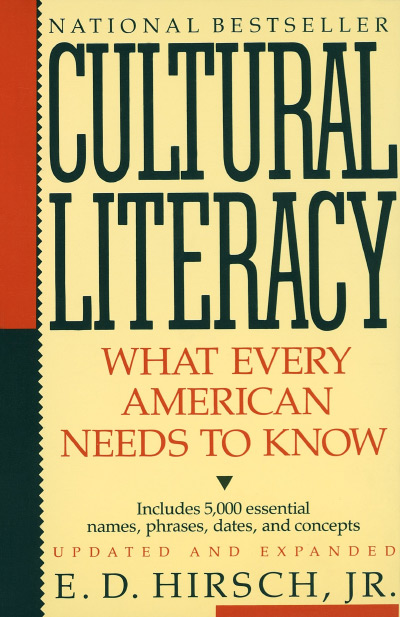 Cultural Literacy: What Every American Needs to Know, by E.D. Hirsch Jr. Rev. ed., Vintage, 1988.
Cultural Literacy: What Every American Needs to Know, by E.D. Hirsch Jr. Rev. ed., Vintage, 1988.
A reader on Goodreads writes: “Hirsch argues for American educators to return to a focus on cultural literacy, meaning a common body of knowledge that literate citizens within a nation possess. Mere literacy, the ability to sound out or read individual words, is not coterminous with cultural literacy, which is a deeper familiarity with a body of concepts shared by one’s compatriots. Cultural literacy is essential to efficient and effective communication. It is a prerequisite for general readers to grasp material written in newspapers, magazines, and literature. For example, community college students struggled with a short article describing the surrender of Lee to Grant at Appomattox. The description of this event assumed familiarity that the students did not have with the Civil War, the Union, the Confederacy, General Ulysses S. Grant, and General Robert E. Lee. Exhaustive understanding of each term is not required. But a basic sketch, or schemata, of who the relevant players, issues, and events were, and how they fit together, was required to understand that particular article and nearly all others. If every term had to be defined in every piece of writing, all writing would be unwieldy. Writers assume a general level of understanding from readers. When readers lack the assumed level of understanding, they are either less likely to read at all, or each undertaking will be a tedious struggle with much information lost in the process. Short term memory fails after about seven seconds or seven items. Precise forms are lost quickly, but the gist of an idea can be retained much longer. When basic facts are converted to long-term memory, they can be called upon to inform reading.” The book includes a list of 5000 names, dates, phrases, and concepts that everyone should know.
“Democratic Education,” by C.S. Lewis, Time and Tide, vol. 25 (April 29, 1944): 369-70.
C.S Lewis warns that the heavy emphasis on egalitarianism in the schoolhouse will have deleterious effects on children of different aptitudes. He writes, “For example, an education which gave the able and diligent boys no advantage over the stupid and idle ones, would be in one sense democratic. It would be egalitarian and democrats like equality. The caucus race in Alice in Wonderland, where all the competitors won and all got prizes, was a ‘democratic’ race: like the Garter it tolerated no nonsense about merit. Such total egalitarianism in education has not yet been openly recommended, but a movement in that direction begins to appear. It can be seen in the growing demand that subjects which some boys do very much better than others should not be compulsory. Yesterday it was Latin—today, as I see from a letter in one of the papers, it is Mathematics. Both these subjects give an ‘unfair advantage’ to boys of a certain type. To abolish that advantage is therefore in one sense ‘democratic.’...
“The demand for equality has two sources—one of them is among the noblest, the other is the basest of human emotions. The noble source is the desire for fair play. But the other source is the hatred of superiority. At the present moment it would be very unrealistic to overlook the importance of the latter. There is in all men a tendency (only corrigible by good training from without and persistent moral effort from within) to resent the existence of what is stronger, subtler or better than themselves. In uncorrected and brutal men this hardens into an implacable and disinterested hatred for every kind of excellence.”
“Developmentalism: An Obscure but Pervasive Restriction on Educational Improvement,” by J.E. Stone. Education Policy Analysis Archives, vol. 4, no. 8 (April 1996): 1-29. Download PDF
ERIC: “Developmentalism is an educational doctrine that presumes natural development to be optimal and requires that teaching practices overcome a presumption that they interfere with an optimal developmental trajectory. It actually impedes efforts to hold schools accountable for student achievement in that it rejects or ignores research on best teaching practices.”
“Do We Have, or Have We Had, a Literary Canon in Our Secondary Schools? What Literature Surveys Reveal,” by Sandra Stotsky. Paper presented at the 80th Annual Meeting of the National Council of Teachers of English (Atlanta, Ga., November 16-21, 1990). Download PDF
ERIC: “[This] study investigated the contention that secondary school literature programs have offered, and continue to offer, what could be construed as a literary canon, a relatively small body of literary texts to which a majority of students have been and are continuing to be exposed. Several surveys of the literary works teachers assign, dating back to 1907, were examined and revealed several trends. First, there is a clear shift from a predominantly British curriculum to a predominantly American one from 1907 to 1990. A study of students’ reading interests in 1950 revealed that major changes in the literature curriculum had taken place by mid-century. Only 12 titles on a 1964 list had also been on the 1907 survey list, and almost half of the top 40 titles were by Americans. Second, many major characters in works of fiction are now adolescents. Third, many of the top 40 titles for grades 7-12 are now suitable for students with moderate reading ability. Finally, there seems to be a decline in tales of adventure and humor as well as in collections of poems and serious essays. To judge by these lists, there does not seem to be any strong evidence for the existence of a canon in high school literature programs over the past century. Most secondary school students in this country now read few literary works in common.”
 The Ecological Indian: Myth and History, by Shepard Krech III. W.W. Norton & Company, 2000.
The Ecological Indian: Myth and History, by Shepard Krech III. W.W. Norton & Company, 2000.
Krech’s scholarly evidence counters the Romantic-era ideal of the Noble Savage, which has been adopted by environmentalists. Curriculum writers need to look carefully at evidence on such matters as Indian overhunting of beaver and white-tailed deer.
Adrian Tanner writes, “The extensive literature on [the deliberate setting by Indians of forest and brush fires] shows that Indians in all parts of the continent used fire. ... While in some instances this was done to improve hunting, [Krech] shows that fires were also set during wars against trespassing groups, both whites and other Indians, and for communication with other Indians. ... Krech refers to several settlers’ anecdotes about Indian-set fires that got out of control. ...
“[Indians’] practice of slaughtering whole herds, at a buffalo jump or in an enclosure, sometimes produced more carcasses than a group could possibly use. [Krech] documents instances of Indians leaving animals to rot, utilising only the cows, or taking only the tongues and the humps.”
“Educational Interventions to Advance Children’s Scientific Thinking,” by David Klahr, Corinne Zimmerman, and Jamie Jirout. Science Magazine, vol. 333 (August, 19 2011): 971–975.
Klahr, Zimmerman, and Jirout write, “At each grade level, direct instruction was the most effective for immediate learning, near-transfer assessments, far-transfer assessments (in new contexts), and remote-transfer assessments (after delays of months or even years). Subsequent studies have replicated the general finding that explicit instruction was most effective in the short and long term, in both carefully controlled single-classroom studies as well as large-scale interventions (36 classrooms with nearly 800 total students).”
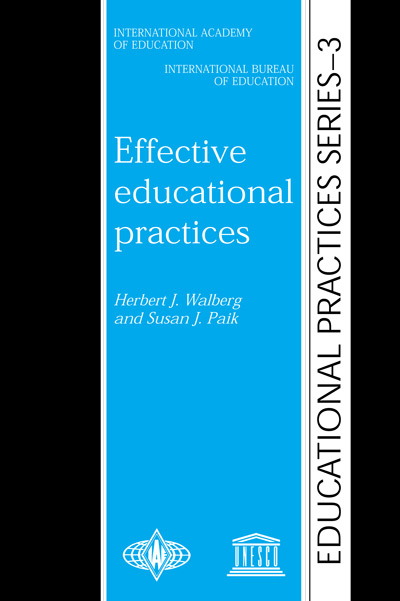 Effective Educational Practices, by Herbert J. Walberg and Susan J. Paik. International Academy of Education, 2000. Download PDF
Effective Educational Practices, by Herbert J. Walberg and Susan J. Paik. International Academy of Education, 2000. Download PDF
ERIC: “This booklet focuses on aspects of effective education that appear to be universal in formal schooling. The practices, which are generally for use in elementary and secondary classrooms, show large, positive learning effects for students in widely varying conditions. Information in the booklet is based on research spanning half a century. Each section begins by presenting findings from the research, then follows up with a discussion of the topic in the classroom. The 10 sections are as follows: (1) ‘Parent Involvement’; (2) ‘Graded Homework’; (3) ‘Aligned Time on Task’; (4) ‘Direct Teaching’; (5) ‘Advance Organizers’; (6) ‘The Teaching of Learning Strategies’; (7) ‘Tutoring’; (8) ‘Mastery Learning’; (9) ‘Cooperative Learning’; and (10) ‘Adaptive Education.’”
“Ethnomathematics,” by Diane Ravitch, Wall Street Journal, June 20, 2005.
Ravitch writes, “[M]athematics is being nudged into a specifically political direction by educators who call themselves ‘critical theorists.’ They advocate using mathematics as a tool to advance social justice. Social justice math relies on political and cultural relevance to guide math instruction. One of its precepts is ‘ethnomathematics,’ that is, the belief that different cultures have evolved different ways of using mathematics, and that students will learn best if taught in the ways that relate to their ancestral culture. From this perspective, traditional mathematics—the mathematics taught in universities around the world—is the property of Western Civilization and is inexorably linked with the values of the oppressors and conquerors. The culturally attuned teacher will learn about the counting system of the ancient Mayans, ancient Africans, Papua New Guineans, and other ‘non-mainstream’ cultures.
“Partisans of social justice mathematics advocate an explicitly political agenda in the classroom. A new textbook, Rethinking Mathematics: Teaching Social Justice by the Numbers, shows how problem solving, ethnomathematics, and political action can be merged. Among its topics are: ‘Sweatshop Accounting,’ with units on poverty, globalization, and the unequal distribution of wealth. Another topic, drawn directly from ethnomathematics, is ‘Chicanos Have Math in Their Blood.’ ... The theory behind the book is that ‘teaching math in a neutral manner is not possible.’ Teachers are supposed to vary the teaching of mathematics in relation to their students’ race, gender, ethnicity, and community.”
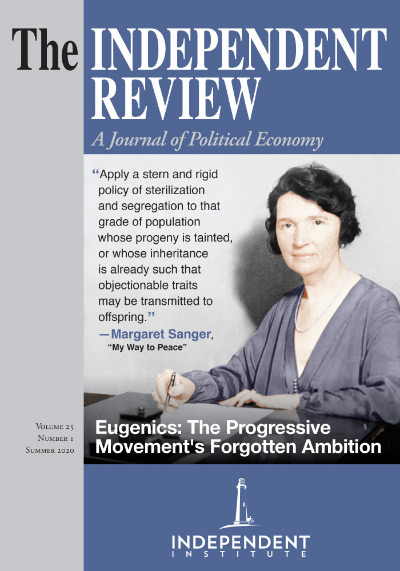 “Eugenics in High School History: Failure to Confront the Past,” by Thomas F. Cargill. The Independent Review, vol. 25, no. 1 (Summer 2020): 5–25. Download PDF
“Eugenics in High School History: Failure to Confront the Past,” by Thomas F. Cargill. The Independent Review, vol. 25, no. 1 (Summer 2020): 5–25. Download PDF
The history of eugenics and scientific racism is missing from America’s high school history textbooks. Is the interweaving of these ideas with the rest of progressivism and their support by the early-twentieth-century progressive movement too revealing?
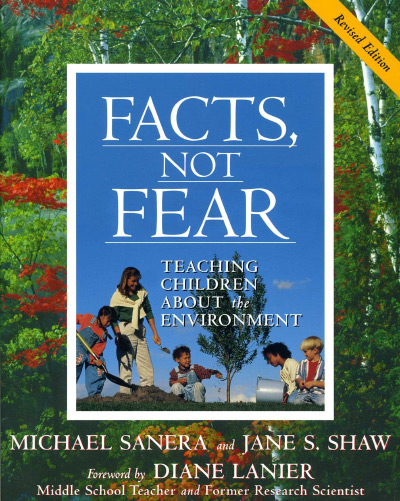 Facts, Not Fear: A Parent’s Guide to Teaching Children About the Environment, by Michael Sanera and Jane Shaw. Gateway Books, 1996.
Facts, Not Fear: A Parent’s Guide to Teaching Children About the Environment, by Michael Sanera and Jane Shaw. Gateway Books, 1996.
Gregory Rehmke writes, “Facts, Not Fear ... succeeds in explaining environmental issues in straightforward and uncomplicated language. Sections on population, natural resources, rain forests, and wildlife all begin with quotations from school textbooks and then calmly compare gloomy textbook perspectives on these topics with the research of leading scholars. Facts, Not Fear demonstrates convincingly that school textbooks are misinforming young people about environmental issues.
“The authors maintain an even and careful tone while pointing out the disparity between what textbooks try to teach children, and what scientific and economic research suggests should be taught. In the beginning of the book, the established experts that have reviewed each of the chapters on environmental topics are listed along with their academic affiliations. Leading economists reviewed sections on population, natural resources, and water, and a variety of scientists reviewed sections on forests, wildlife, greenhouse warming, the ozone layer, acid rain, and pesticides. Detailed notes and references for each chapter make it easy for skeptical readers to check out key sources themselves.”
“The Federal Bilingual Education Program,” by Christine H. Rossell. Brookings Papers on Educational Policy, no. 3 (2000): 215-264.
Rossell writes, “No studies showed [transitional bilingual education] to be better than structured immersion in reading, language, and math.”
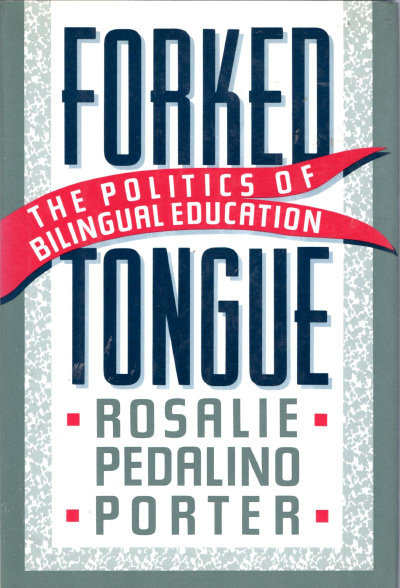 Forked Tongue: The Politics of Bilingual Education, by Rosalie Pedalino Porter. Basic Books, 2006.
Forked Tongue: The Politics of Bilingual Education, by Rosalie Pedalino Porter. Basic Books, 2006.
Andrew Hacker writes, “Makes the persuasive case against ethnic empire building ... It suggests that much time and money may have been wasted in classrooms where children were supposed to be learning to read and write English and did not.”
“German as the Classroom Language at Andover,” by Walter F.W. Lohnes. The German Quarterly, vol. 33, no. 4 (November 1960): 331-336.
Lohnes describes the approach to foreign-language instruction that combines the structural approach with the communicative approach. Lohnes went on to co-author a well-regarded German textbook incorporating these principles.
“How Can Educators Teach Critical Thinking?” by Daniel T. Willingham. American Educator (American Federation of Teachers), Fall 2020.
Willingham writes, “[I]dentify what’s meant by critical thinking in each domain. Be specific by focusing on tasks that tap skills, not skills themselves. What tasks showing critical thinking should a high school graduate be able to do in mathematics, history, and other subjects? For example, educators might decide that an important aspect of understanding history is the ability to source historical documents; that is, to interpret them in light of their source—who wrote it, for what purpose, and for what intended audience. Educators might decide that a key critical thinking skill for science is understanding the relationship between a theory and a hypothesis. These skills should be explicitly taught and practiced—there is evidence that simple exposure to this sort of work without explicit instruction is less effective.
“[D]omain knowledge is a crucial driver of thinking skill. What knowledge is essential to the type of thinking you want your students to be able to do? For example, if students are to source documents, they need knowledge of the relevant source; in other words, knowing that they are reading a 1779 letter from General George Clinton written to George Washington with a request for supplies won’t mean much if they don’t have some background knowledge about the American Revolutionary War—that will enable them to make sense of what they read when they look up Clinton and his activities at the time.”
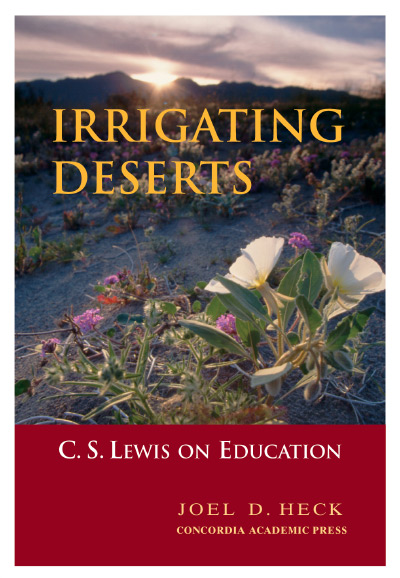 Irrigating Deserts: C.S. Lewis on Education, by Joel D. Heck. Concordia Publishing House, 2006.
Irrigating Deserts: C.S. Lewis on Education, by Joel D. Heck. Concordia Publishing House, 2006.
Concordia Publishing House: “Lewis forged a strong understanding of the value of education in life. What he proposed and illustrated in his writings and modeled in the classroom is a passion for education in the classical tradition and a commitment to truth in the context of the Christian faith. Lewis’ defense of objective truth and the kind of curriculum that would support such truth form the foundation of his thought.
“Views on the purpose of education, model schools, and the Inner Ring also are explored along with the effectiveness of Lewis’s use of analogy and other techniques to shape both the heads and the hearts of his students. The analysis of Lewis’s educational philosophy and practice culminates in application of this philosophy and practice to current issues and challenges in modern education and modern Christian education: objective truth, pedagogy, curriculum, interdisciplinary thinking, the purpose of education, head and heart, and much more.”
Is It Time for a 490 B.C Project?, by Morgan E. Hunter, Williamson M. Evers, and Victor Davis Hanson. Independent Institute, 2020. Download PDF
A report detailing the history of the teaching of classics in America, the deficiencies of current teaching, and a sketch of a better curriculum.
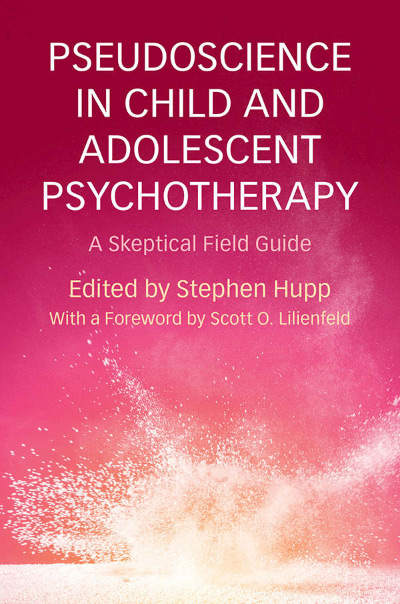 “Learning,” by Zachary LeBrot and Brad Dufrene. In Pseudoscience in Child and Adolescent Psychotherapy: A Skeptical Field Guide, ed. by Stephen Hupp. Cambridge University Press, 2019, pp. 66-79.
“Learning,” by Zachary LeBrot and Brad Dufrene. In Pseudoscience in Child and Adolescent Psychotherapy: A Skeptical Field Guide, ed. by Stephen Hupp. Cambridge University Press, 2019, pp. 66-79.
LeBrot and Dufrene write, “Approximately, 5%-15% of school-age children experience [a Specific Learning Disorder] that impairs their ability to succeed academically and occupationally. Numerous procedures have been developed to address learning difficulties associated with SLD and subsequently promote academic outcomes. Several of these procedures (e.g., educational kinesiology, vision therapies, and working memory training) have little to no empirical support for improving academic outcomes for struggling readers. Unfortunately, these approaches have been widely disseminated and marketed to parents and educators as quick, simple, and cost-effective procedures for improving learning.”
Learning to Read: Components of Beginning Reading Instruction K-8, by Louisa Cook Moats with Alice R. Furry and Nancy Bownell. California State Board of Education, rev. ed., 1999.
Produced by the California State Board of Education to explain to teachers how to teach young children to read. Well-organized, scientifically-based, clear, and comprehensive.
“Loco, Completamente Loco: The Many Failures of ‘Bilingual Education’,” by Glenn Garvin. Reason Magazine, January 1998.
Garvin writes, “Bilingual education was born [many decades] ago from a good-hearted but vague impulse by Congress to help Spanish speakers learn English. Instead, it has become a multi-billion-dollar hog trough that feeds arrogant education bureaucrats and militant Hispanic separatists. And now poor immigrant parents increasingly see it as the wall around a linguistic ghetto from which their children must escape if they want to be anything more than maids or dishwashers.”
“A Meta-Analysis of Writing Instruction for Adolescent Students,” by Steve Graham and Dolores Perin. Journal of Educational Psychology, vol. 99, no. 3 (2007): 445-476. Download PDF
Graham and Perin write, “[T]he self-regulated strategy development model yielded [quite] large effect sizes. There are many possible reasons why this approach was so effective, including the power of the specific planning or revising strategies taught, the inclusion of instructional procedures to promote self-regulation, or the emphasis on criterion-based rather than time-based instruction. In any event, explicitly teaching students strategies for planning, revising, and editing was effective. ...”
 Molding the Good Citizen: The Politics of High School History Texts, by Robert Lerner Althea K. Nagai, and Stanley Rothman. Praeger, 1995.
Molding the Good Citizen: The Politics of High School History Texts, by Robert Lerner Althea K. Nagai, and Stanley Rothman. Praeger, 1995.
The authors write, “Two different groups are trying to influence textbook content. ... the members of the education system who are *inside* the system and the parents of the children being taught. ... Most authors writing about the pressures to shape curricula and textbooks ignore the complexity of this process. In considering how curricula change, neglecting the role of the education profession leads to a parallel neglect of how textbook content is actually determined.”
Praeger: A series of culture wars are being fought in America today; Lerner, Nagai, and Rothman contend that one key battleground is the nation’s high school texts. ... Conventional wisdom among students of the curriculum is that the major threat to freedom of the schools comes from the religious right. While this may have been true at one time, Lerner, Nagai, and Rothman assert that the major thrust today involves the imposition on schools of the ideology of particular groups that seek to use education as a mechanism for changing society. ...
The authors document the growing influence of these groups, and their supporters among educators, in two ways. First, they present an extensive quantitative content analysis of leading high school history texts over the past 40 years, demonstrating in detail the feminist and multicultural perspectives that have come to dominate them. Second, they provide a historical analysis of how this outlook and the willingness to impose it became part of educators’ conventional wisdom, tracing current policies back to the influence of the Progressive education movement led by John Dewey.
ERIC: This study concentrates on the role textbooks play in the debate over civic education. It examines education’s role in reflecting and producing social change. This examination is based on a quantitative, content-analytical study of the leading high school United States history textbooks from the past 50 years, and the historical record of the teaching profession. Chapters are entitled: (1) Introduction: Textbooks and Citizen Education; (2) Progressive Thought and the Rise of the Progressive Era Intellectual Class; (3) Progressive Education Changes the Curriculum; (4) Filler Feminism in High School History Textbooks; (5) History by Quota? (6) On Judging Civilizations: The Discovery of America, Noble Savages, and the Like; (7) The Rise of American Capitalism: The Story of the Robber Barons; (8) Historical Hindsight and Appraising Presidents; and (9) Conclusion: Education and Civic Order.
“The New New Math,” by Martin Gardner. New York Review of Books, September 24, 1998: 9–12.
Gardner was the well-known mathematical puzzle columnist in the Scientific American and author of Fads and Fallacies in the Name of Science. Gardner writes, “Recently, the [National Council of Teachers of Mathematics], having learned little from its New Math fiasco [in the 1960s], has once more been backing another reform movement that goes by such names as the New New Math, whole math, fuzzy math, standards math, and rain forest math. Like the old New Math, it is creating a ferment among teachers and parents, especially in California, where it first caught on. It is estimated that about half of all pre-college mathematics in the United States is now being taught by teachers trained in fuzzy math. The new fad is heavily influenced by multiculturalism, environmentalism, and feminism.”
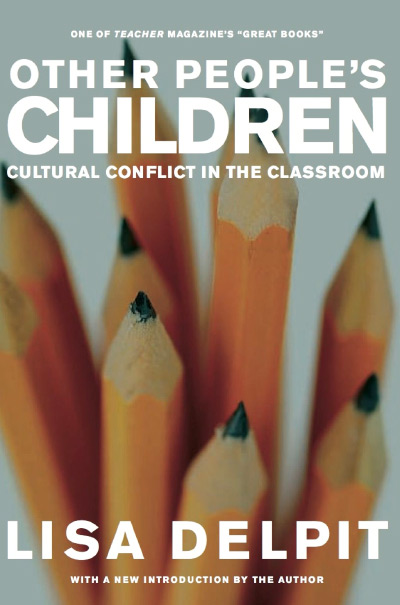 Other People’s Children: Cultural Conflict in the Classroom, by Lisa Delpit. Rev. ed., New Press, 2006.
Other People’s Children: Cultural Conflict in the Classroom, by Lisa Delpit. Rev. ed., New Press, 2006.
Delpit discusses how it is that teaching strategies such as “whole language” and “process not product” often lead to academic failure for nonwhite students. E.D. Hirsch Jr. writes, “Delpit, a brilliant African American educator, [has] critical things to say about constructivist methods in teaching African American students in her book. ... She pointed out the language of the classroom itself was often meaningless to black students and to other students whose language and shared knowledge was not that of the American print culture that more advantaged American kids absorbed at home. She was particularly critical of methods that we now call constructivist: discovery learning, inquiry learning, and methods that ask children to work things out for themselves. How are they supposed to do that? she asked. They don’t know what you [the teacher] are talking about.”
“‘Physics First’ Is Not the Best Way to Teach Every Science Student,” by Dean Papadakis. Position paper for panel discussion, SED 625SC, Santa Clara University, October 25, 2006.
In 2005 (three years after the San Diego Unified School District adopted the non-mathematical “Active Physics” program as part of a physics-first science course sequence), only 10% of all San Diego students scored at proficient or advanced levels on the physics California Standards Test, and—even more troubling—only about 2% of African-American and Latino students scored at proficient or advanced. This led the district to eliminate the physics-first sequence beginning in 2007-2008.
“PISA Shows Inquiry-Based Learning a Failure, Alas,” by Viktor Blåsjö. Intellectual Mathematics, December 6, 2016.
From the article: “The ... PISA study [PISA 2015 Results (Volume II): Policies and Practices for Successful Schools] is prima facie a massive blow to educational reform ideology and a strong vindication of traditionalist advocates of direct instruction. The data seems to show that teacher-directed instruction is associated with success even more than the school’s socio-economic profile, while inquiry-based learning is a surer way to fail than skipping class.”
“Principles of Instruction: Research-Based Strategies That All Teachers Should Know,” by Barak Rosenshine. American Educator (American Federation of Teachers), Spring 2012: 12-19, 39. Download PDF
Summary of evidence-based methods of effective teaching. Rosenshine writes, “Education involves helping a novice develop strong, readily accessible background knowledge. It’s important that background knowledge be readily accessible, and this occurs when knowledge is well rehearsed and tied to other knowledge.
“The most effective teachers ensured that their students efficiently acquired, rehearsed, and connected knowledge by providing a good deal of instructional support. They provided this support by teaching new material in manageable amounts, modeling, guiding student practice, helping students when they made errors, and providing for sufficient practice and review.
“Many of these teachers also went on to experiential, hands-on activities, but they always did the experiential activities after, not before, the basic material was learned.”
“A Quarter Century of U.S. ‘Math Wars’ and Political Partisanship,” by David Klein. BSHM Bulletin: Journal of the British Society for the History of Mathematics, vol. 22, no. 1 (2007): 22-33.
David Klein, a university mathematics professor and New Left historian of math education, writes, “Why did disagreements about school mathematics books in the US diverge according to left and right politics? Part of the answer is historical. The roots of progressive education are intertwined with ... ideals from the Romantic Era. In addition, progressive educators ... argued that women and members of ethnic minority groups learn mathematics differently from white males. Such views were harmonious with the politically liberal ethnic-identity ideologies popular during this period, especially in universities. Taking into account the anti-elitism and social justice arguments surrounding constructivist mathematics programmes, it is then not surprising that multiculturalists and liberals would be attracted to the [National Council of Teachers of Mathematics] vision, even if they did not understand the mathematical issues involved. As those groups constituted parts of the electoral base for Democratic politicians, the latter would be reluctant to challenge the use of constructivist maths in schools. ... Ironically, progressivists’ advocacy of such mathematics programmes for the supposed benefit of disenfranchised groups contributed to racial stereotyping.”
“Radical Constructivism and Cognitive Psychology,” by John R. Anderson, Lynne M. Reder, Herbert A. Simon, K. Anders Ericsson and Robert Glaser. Brookings Papers on Educational Policy, no. 1 (1998): 227-278.
A critique by cognitive psychologists of radical constructivist teaching methods in the K-12 classroom. The authors write, “Radical constructivism emphasizes discovery learning, learning in complex situations, and learning in social contexts, while strongly distrusting system evaluation of educational outcomes.”
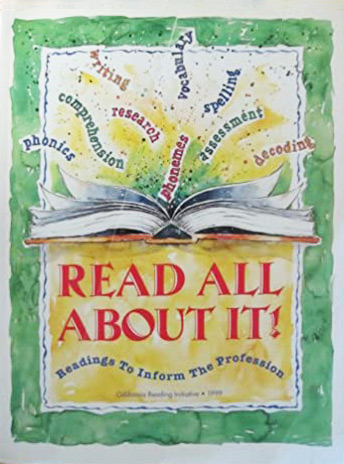 Read All About It!: Readings To Inform The Profession. California State Board of Education, 1999.
Read All About It!: Readings To Inform The Profession. California State Board of Education, 1999.
Produced by the California State Board of Education to offer teachers accessible research articles on how to teach young children to read.
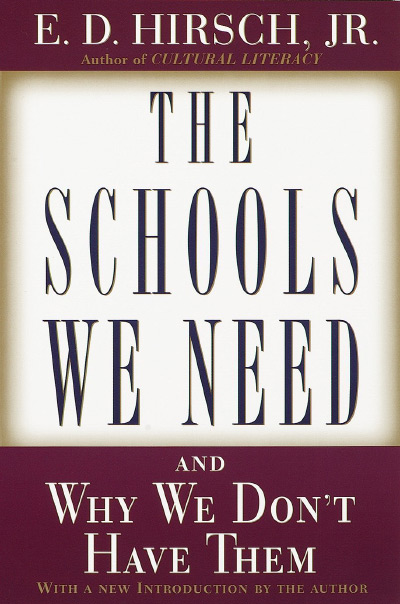 The Schools We Need and Why We Don’t Have Them, by E.D. Hirsch Jr. Anchor Books, 1999.
The Schools We Need and Why We Don’t Have Them, by E.D. Hirsch Jr. Anchor Books, 1999.
As Jeremiah Reedy summarizes Hirsch’s thesis, “The chief cause of our educational failures is a mistaken philosophy of education derived from Rousseau via John Dewey. This misguided philosophy, known as ‘progressive education,’ is based on the romantic notion that each child has an innate, instinctive tendency to follow its own proper development. Hirsch writes that, firstly, Romanticism held ‘that human nature is innately good, and should therefore be encouraged to take its natural course, unspoiled by the artificial impositions of social prejudice and convention. Second, Romanticism concluded that the child is neither a scaled-down, ignorant version of the adult nor a formless piece of clay in need of molding, rather, the child is a special being ... with unique, trustworthy—indeed holy—impulses that should be allowed to develop and run their course.’”
“The Scientific Status of Learning Styles Theories,” by Daniel T. Willingham, Elizabeth M. Hughes, and David G. Dobolyi. Teaching of Psychology, vol. 42, no. 3 (July 2015): 266-271.
From the abstract: “Theories of learning styles suggest that individuals think and learn best in different ways. These are not differences of ability but rather preferences for processing certain types of information or for processing information in certain types of ways. If accurate, learning styles theories could have important implications for instruction because student achievement would be a product of the interaction of instruction and the student’s style. There is reason to think that people view learning styles theories as broadly accurate, but, in fact, scientific support for these theories is lacking. We suggest that educators’ time and energy are better spent on other theories that might [actually] aid instruction.”
“The Serpent in Finland’s Garden of Equity,” by Sandra Stotsky. (Essay Review of Finnish Lessons: What Can the World Learn from Educational Change in Finland, by Pasi Sahlberg. Pioneer Institute Policy Brief, February 2012. Download PDF
Stotsky writes, “[T]here is at least one visible snake in the Garden of Equity. ... Finnish educators ... [have promoted] a particular kind of mathematics curriculum in its teacher training schools. Perhaps they deliberately intended to reduce the mathematical content traditionally taught in 1-9 in order to slow down the ‘gaps in achievement’ that study of mathematics as a discipline typically leads to. Whether or not it was their intention, an emphasis on equality of outcome was bound to lead to the ‘mathematics of daily life’ for all rather than to the ‘structure of mathematics’ for those with interest and aptitude for mathematics, as mathematicians have characterized the differences. For two decades, they have expressed concerns about the rigor of the mathematics curriculum in grades 1-9 because its deficiencies have spilled over into Finland’s high schools, universities, and polytechnic schools. ... Mathematics instructors have also pointed to an unhealthy relationship between the PISA tests and this weak curriculum in grades 1-9.”
“Should There Be a Three-Strikes Rule against Pure Discovery Learning? The Case for Guided Methods of Instruction,” by Richard E. Mayer. American Psychologist, vol. 59, no. 1 (2004): 14–19.
Abstract: “The author’s thesis is that there is sufficient research evidence to make any reasonable person skeptical about the benefits of discovery learning—practiced under the guise of cognitive constructivism or social constructivism—as a preferred instructional method. The author reviews research on discovery of problem-solving rules culminating in the 1960s, discovery of conservation strategies culminating in the 1970s, and discovery of LOGO programming strategies culminating in the 1980s. In each case, guided discovery was more effective than pure discovery in helping students learn and transfer. Overall, the constructivist view of learning may be best supported by methods of instruction that involve cognitive activity rather than behavioral activity, instructional guidance rather than pure discovery, and curricular focus rather than unstructured exploration.”
 The 1619 Project: A Critique, by Phillip W. Magness. American Institute for Economic Research, 2020. [Read Summary]
The 1619 Project: A Critique, by Phillip W. Magness. American Institute for Economic Research, 2020. [Read Summary]
This short, accessible book is a criticism of aspects of an influential proposed curriculum on the role of African slavery in American history. Economic historian Magness writes, “In its worst instances, the 1619 Project amounts to an unscholarly mess of historical misrepresentations, economic fallacy, and an explicit anti-capitalist ideological agenda. To the project’s further discredit, the [New York] Times’ editors and main contributors have adopted a dismissive stance in response to substantive criticism, including a refusal to correct documented factual errors among its historical claims.”
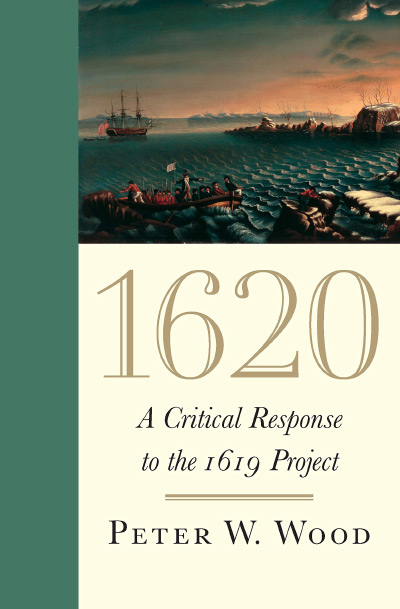 1620: A Critical Response to the 1619 Project, by Peter W. Wood. Encounter Books, 2020.
1620: A Critical Response to the 1619 Project, by Peter W. Wood. Encounter Books, 2020.
Wood writes, “The 1619 Project is, arguably, part of a larger effort to destroy America by people who find it unbearably bad. The project treats the founding principles of our nation as an illusion—a contemptible illusion. In their place is a single idea: that America was founded on racist exploitation.”
William Allen writes, “Peter Wood’s 1620 claims the prize as the most comprehensive response to the ill-fated 1619 Project. In a thorough review of the text, Wood accounts for every argument for and against. He appropriately honors the [1619] Project’s intention to pursue a mission of redress, while nevertheless pinpointing its consistent resort to misrepresentation that cannot be dismissed as merely different interpretation. Wood identifies the heart of the matter: Surely there are ways to incorporate a forthright treatment of slavery, racism, and the black experience into the story of America’s rise as a free, self-governing, creative, and prosperous nation. The key to doing that is to put the pursuit of the ideals of liberty and justice at the center of the story. The 1619 Project failed in that for the sufficient reason that its purpose was cultural shakedown, not cultural affirmation. That is made plain in this necessary work."
“Started in Slavery, Founded in Freedom: 1619 vs. 1776,” by S. Adam Seagrave. RealClearPublicAffairs.com, April 30, 2020.
Seagrave writes, “[T]he focus of critics has been concentrated on the title page of Hannah-Jones’s essay—‘Our founding ideals of liberty and equality were false when they were written’—and Jake Silverstein’s ‘editor’s note’ introducing the project. And then, of course, there is the title: 1619.
“What do these parts of the project jointly convey? That American identity—stated in terms of ‘true birth date’ or ‘origin’—is an either/or and that 1776 must be rejected as a legitimate competitor to 1619 in this determination. The year 1619, in other words, preempts and nullifies 1776. . . . So what’s really at stake in the 1619 vs. 1776 debate is whether the revolutionary principles of 1776 are capable of providing [something to shoot for, a target at which to aim. We have to have somewhere we are going to, not just somewhere we are coming from.] The question is whether the undeniable historical fact of the preexistence of American slavery tainted or invalidated entirely the ideas and arguments about natural human rights that motivated and justified the American Revolution—and that, presumably, have continued to motivate and justify the American experiment in self-government from that time to ours.”
“Teaching General Problem-Solving Skills Is Not a Substitute for, or a Viable Addition to, Teaching Mathematics,” by John Sweller, Richard Clark, and Paul Kirschner. Notices of the American Mathematical Society, vol. 57, no. 10 (November 2010): 1303-1304. Download PDF
The authors write, “Recent ‘reform’ curricula both ignore the absence of supporting data and completely misunderstand the role of problem solving in cognition. If, the argument goes, we are not really teaching people mathematics but rather are teaching them some form of general problem solving, then mathematical content can be reduced in importance. According to this argument, we can teach students how to solve problems in general, and that will make them good mathematicians able to discover novel solutions irrespective of the content. We believe this argument ignores all the empirical evidence about mathematics learning.”
“There Is No Such Thing as ‘White’ Math,” by Sergiu Klainerman, Common Sense with Bari Weiss, March 1, 2021.
Klainerman, a professor of mathematics at Princeton, writes, “Attempts to ‘deconstruct’ mathematics, deny its objectivity, accuse it of racial bias, and infuse it with political ideology have become more and more common—perhaps, even, at your child’s elementary school. ... Unlike the traditional totalitarianism practiced by former communist countries, like the Romania I grew up in, this version is soft. It enforces its ideology not by jailing dissenters or physically eliminating them, but by social shaming, mob punishment, guilt by association, and coerced speech. When it comes to education, I believe the woke ideology is even more harmful than old-fashioned communism.
"The ability of mathematics to provide right answers to well-formulated problems is not something specific to one culture or another; it is really the essence of mathematics. To claim otherwise is to argue that somehow the math taught in places like Iran, China, India or Nigeria is not genuinely theirs but borrowed or forged from ‘white supremacy culture.’ It is hard to imagine a more ignorant and offensive statement."
“The Third Mathematics Education Revolution,” by Richard Askey. Contemporary Issues in Mathematics Education, vol. 36 (1999):, 95-107. Download PDF
What’s wrong and what’s missing in K-12 math education. Includes detailed discussion of a textbook.
“Tot Sociology: Or What Happened to History in the Grade Schools,” by Diane Ravitch. American Scholar, vol. 56, no. 3 (Summer 1987): 343-354.
Ravitch writes, “Some progressive educators wanted to broaden the curriculum in response to the growing numbers of ‘nonacademic’ students in high school; the ‘social reconstructionist’ wing of progressive education wanted the schools to play a leading role as an agency of social and political reform. The latter group (centered at Columbia Teachers College) agreed that the era of individualism was finished, and a new collectivist age was struggling to be born; within the curriculum, the social studies portion was expected to prepare the citizens of the future for lives of interdependence and democratic collectivism. ...
“The ... curriculum in Virginia [devised in the early 1930s] was vintage progressive education in that it sought to replace traditional subject matter with real-life problem solving. ... It was organized around what [Paul] Hanna called ‘unitary life experiences’ rather than such traditional subject matter as history, civics, and geography. ... The ‘expanding environments’ curriculum in the early grades dropped the historical part of the social studies curriculum and replaced it with a sociological and economic emphasis on home, school, and community. ... Hanna lauded the idea of ‘children as community builders,’ and urged that children be enlisted as active agents in the cooperative solution of community problems. ... [F]irst, second, and third graders had to learn to contribute to the good of society. ... [T]he expanding environments approach was established not as a result of the findings of cognitive or developmental psychology, but as a result of specific social and political values.”
“The Tracking and Ability Grouping Debate,” by Tom Loveless. The Fordham Report, vol. 2, no. 8 (August 1998). Download PDF
ERIC: “Tracking and ability grouping are common practices that are often harshly criticized. Both practices group students of similar achievement levels for instruction, but they differ in how this task is accomplished. Elementary schools typically use ability grouping in reading instruction, with instruction targeted to the reading level of each group. Middle and high schools use tracking to group students between classes, offering courses in academic subjects that reflect differences in students’ prior learning. .... Research has indicated that ... when the curriculum is adjusted to correspond to ability level, ... student achievement is boosted, especially for high ability students receiving an accelerated curriculum. ... In the past, tracking was rigid and deterministic, but today, schools assign students to tracks for particular subject areas based on proficiency. ... Catholic high schools appear to provide low-track students with a quality education, and they are remarkably similar in boosting low-track students to higher levels.”
Tracking and Detracking: High Achievers in Massachusetts Middle Schools, by Tom Loveless. Thomas B. Fordham Institute, 2009. Download PDF
Chester E. Finn Jr. and Amber M. Winkler write, “Middle schools with more tracks have significantly more math pupils performing at the advanced and proficient levels and fewer students at the needs-improvement and failing levels. What’s more—and this is important—a mirror image of this trend appears for de-tracked schools. In other words, they also have more failing and needs-improvement math students than schools with two or three tracks. In fact, a declining number of failing math students is linked to each additional track in the school, i.e., schools with one track have the most failing math students (26 percent), schools with two tracks fewer (20 percent), and schools with three or more tracks fewer failures still (14 percent).
“[W]hen schools’ socioeconomic status is held constant, each additional track in eighth-grade math (up to three) is associated with a 3 percentage-point rise in students’ scoring at the advanced level. That means the advantage for a school offering three tracks instead of one is associated with a 6 percentage-point gain in the number of students performing at high levels. That may not look like much to you, but it could have considerable impact. The average middle school in Massachusetts can boast just 18 percent of its students at the advanced level in math—and many schools have no students who reach such altitudes. Increasing the proportion of high achievers by six percentage points—that’s eighteen kids in an eighth-grade class of 300—could have a dramatic impact on other students, as well as on the school’s culture.”
 The War Against Grammar, David Mulroy. Heinemann, 2003.
The War Against Grammar, David Mulroy. Heinemann, 2003.
Taking aim at a popular view today that teaching traditional grammar to students is a waste of time, author David Mulroy makes the case that, to the contrary, emphasis on grammar helps with reading comprehension and writing skills.
“What Works, What Doesn’t,” by John Dunolosky, Katherine A. Rawson, Elizabeth J. Marsh, Mitchell J. Nathan, and Daniel J. Willingham. Scientific American Mind (October 2013): 47-53. Download PDF
How students should study in order to learn the subject matter. The authors write, “[I]n the educational system, the emphasis is on teaching students critical-thinking skills and content. Less time is spent on teaching them how to learn. The result can be that students who do well in their early years, when learning is closely supervised, may struggle once they are expected to regulate their own learning in high school or college.”
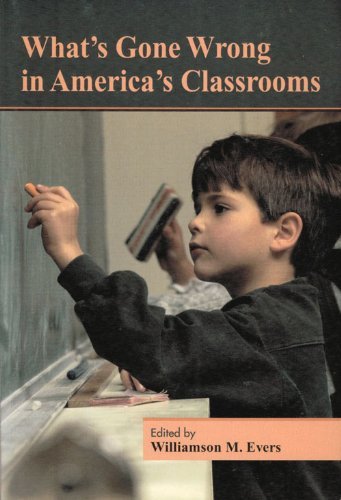 What’s Gone Wrong in America’s Classrooms, ed. Williamson M. Evers. Hoover Institution Press, 1998. Buy from Hoover Institution Press
What’s Gone Wrong in America’s Classrooms, ed. Williamson M. Evers. Hoover Institution Press, 1998. Buy from Hoover Institution Press
ERIC: “This collection of papers examines key failures in modern U.S. education and shows how parents, policymakers, and teachers can make changes that will raise the level of student performance. The papers were presented at a 1997 conference designed to examine how elementary and secondary school students learn and are taught in the classroom. The papers include: ‘From Progressive Education to Discovery Learning’ (Williamson M. Evers); ‘What Is Wrong with American Education?’ (Bonnie Grossen); ‘Reading: A Research-Based Approach’ (Jack M. Fletcher and G. Reid Lyon); ‘Preventing Failure in Early Reading Programs: A Summary of Research and Instructional Best Practice’ (Bill Honig); ‘Spelling and Language Structure: An Essential Foundation for Literacy’ (Louisa Cook Moats); ‘Mathematics Achievement: First in the World by the Year 2000?’ (Harold W. Stevenson); ‘Measurement and Reform’ (Maureen DiMarco); and ‘Research-Based Education Policy’ (E.D. Hirsch Jr.).”
“When a Teaching Moment Lasts Six Hours,” by Daniel T.Willingham. Los Angeles Times, February 28, 2021.
Willingham writes, “Guidance is critical—if kids are given a problem to solve or a frog to dissect with few instructions, they learn much less than they would if they had been given only an explanation. With skillful hints, however, learning from problems and activities can be equivalent, perhaps even a bit better than, learning from a lecture. But [the idea] that solving problems makes learning deeper isn’t true.”
“When Educrats Can’t Even Agree That 2 + 2 = 4, Public Education Is A Joke,” by Katya Sedgwick. The Federalist, August 7, 2020.
A commentary on critical-race-theory math, some of whose proponents argue that 2 + 2 = 5, and some who want to defund math in the K-12 curriculum.
Where Did Social Studies Go Wrong?, ed. James Leming, Kathleen Porter-Magee, and Lucien Ellington. Thomas B. Fordham Foundation, 2003. Download PDF
The editors write, “Why is social studies education in such deep trouble? The contributors believe one reason is the dominant belief systems of the social studies education professoriate who train future teachers in colleges and departments of education. These theorists have created and promoted a philosophy of social studies education that has proven to be both educationally ineffective and contrary to the values of most Americans. The perspectives of these social studies theorists rest upon three premises: (1). American society is morally bankrupt; (2). an elite band of university professors, infused with a passion for social justice, knows best how to reform our flawed society; and, (3). classrooms in our nation’s public schools are an essential battleground for this societal transformation. The theorists’ passion for radical social change and their propensity to use the public schools as a tool to do so, is undoubtedly one reason why social studies is in crisis. It has resulted in a field that eschews substantive content and subordinates a focus on effective practice to educational and political correctness.”
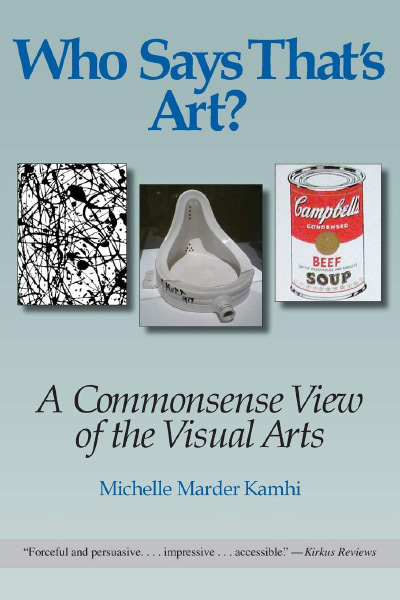 Who Says That’s Art? A Commonsense View of the Visual Arts, by Michelle Marder Kamhi. Pro Arte Books, 2014.
Who Says That’s Art? A Commonsense View of the Visual Arts, by Michelle Marder Kamhi. Pro Arte Books, 2014.
For our purposes, the relevant part of this book is chapter 8, “Rethinking Art Education.” Kamhi writes, “What should [the goal be of visual arts education]—that is, as part of a general education for all children? ... [I]t should be to foster an understanding and appreciation of art as a distinctive and potent mode of human expression. ... My approach is ... at odds with the hands-on studio emphasis that has characterized art education from its inception. ...
“As argued by the late Albert Eisner (1993-2014), then professor of art and education at Stanford University, ‘Most youngsters are not going to be professional artists, but all youngsters can learn to appreciate ... the arts.’”
Whole Language Lives On: The Illusion of “Balanced” Reading Instruction, by Louisa Cook Moats. Thomas B. Fordham Foundation, 2000. Download PDF
ERIC “This position paper contends that the whole language approach to reading instruction has been disproved by research and evaluation but still pervades textbooks for teachers, instructional materials for classroom use, some states’ language-arts standards and other policy documents, teacher-licensing requirements and preparation programs, and the professional context in which teachers work. The paper finds that many who pledge allegiance to ‘balanced reading’ continue to misunderstand reading development and to deliver ‘poorly conceived, ineffective reading instruction.’ It argues that ‘rooting out whole language’ from reading classrooms calls for effort on eight separate fronts. The paper describes what whole language is, why it is contradicted by scientific studies, how it continues in education, and what should be done to correct the situation.”
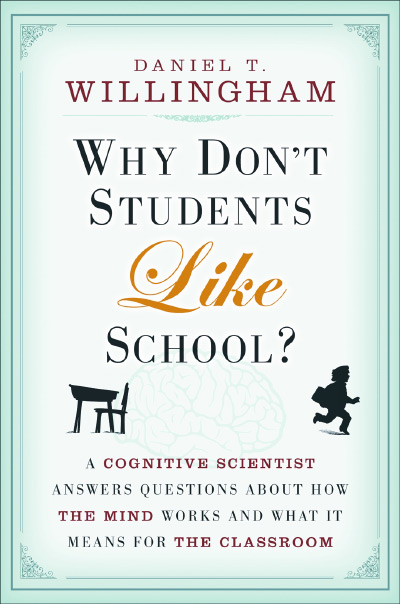 Why Don’t Students Like School?: A Cognitive Scientist Answers Questions about How the Mind Works and What It Means for Your Classroom, by Daniel T. Willingham. Jossey-Bass, 2009.
Why Don’t Students Like School?: A Cognitive Scientist Answers Questions about How the Mind Works and What It Means for Your Classroom, by Daniel T. Willingham. Jossey-Bass, 2009.
Willingham writes, “Contrary to popular belief, the brain is not designed for thinking. It’s designed to save you from having to think, because the brain is actually not very good at thinking. Thinking is slow and unreliable. Nevertheless, people enjoy mental work if it is successful. People like to solve problems, but not to work on unsolvable problems. If schoolwork is always just a bit too difficult for a student, it should be no surprise that she doesn’t like school much. The cognitive principle that guides this article is: People are naturally curious, but they are not naturally good thinkers; unless the cognitive conditions are right, people will avoid thinking. The implication of this principle is that teachers should reconsider how they encourage their students to think in order to maximize the likelihood that students will get the pleasurable rush that comes from successful thought.”
"Why Minimal Guidance During Instruction Does Not Work: An Analysis of the Failure of Constructivist, Discovery, Problem-Based, Experiential, and Inquiry-Based Teaching," by Paul A. Kirschner, John Sweller, and Richard E. Clark, Educational Psychologist, vol. 41, no. 2 (2006): 75-86. Download PDF
From the authors’ abstract: “Although unguided or minimally guided instructional approaches are very popular and intuitively appealing, ... these approaches ignore both the structures that constitute human cognitive architecture and evidence from empirical studies over the past half-century that consistently indicate that minimally guided instruction is less effective and less efficient than instructional approaches that place a strong emphasis on guidance of the student learning process. The advantage of guidance begins to recede only when learners have sufficiently high prior knowledge to provide ‘internal’ guidance. Recent developments in instructional research and instructional design models that support guidance during instruction are briefly described.”








